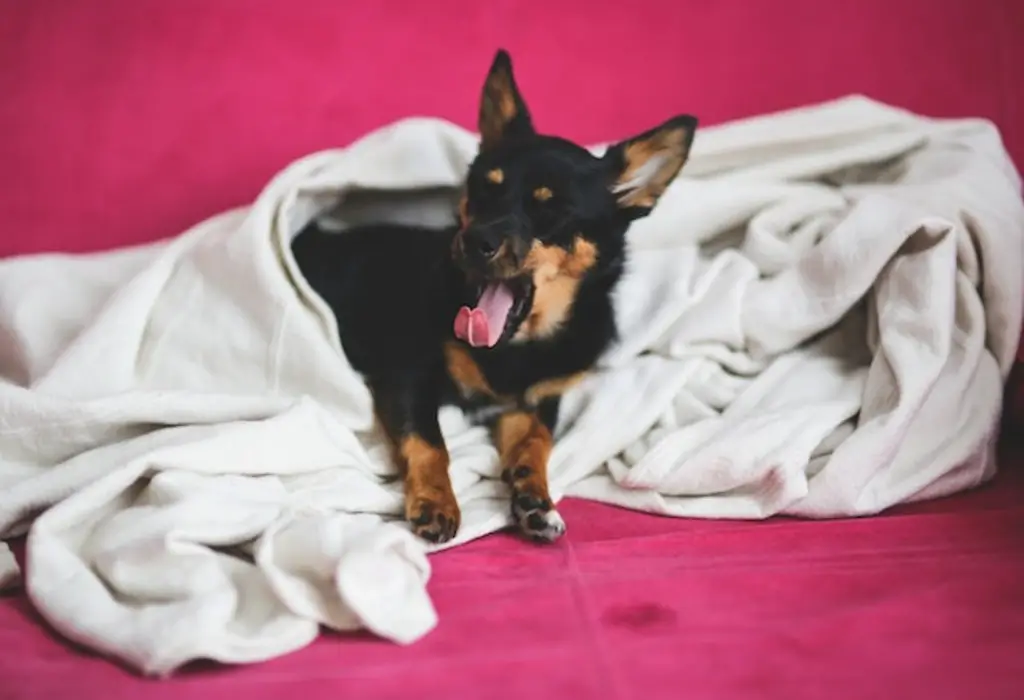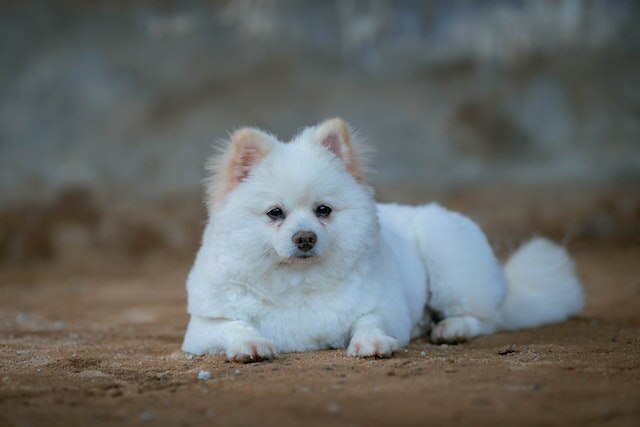Have you ever watched your furry friend take a nap and noticed them twitching or moving their paws? If so, you’re not alone. It’s common to see dogs twitching in their sleep, and it’s important to understand their sleep behavior to ensure their overall wellbeing.
In this article, we’ll dive into the topic of why do dogs twitch in their sleep. We’ll explore the normal canine sleep patterns, understand sleep twitches in dogs, and discuss the factors that affect sleep twitching in dogs. We’ll also debunk some of the common myths surrounding this behavior, learn when to worry about sleep disorders in dogs, and discover ways to improve dogs’ sleep quality.
So, let’s get started and unravel the mystery of why do dogs twitch in their sleep!
Key Takeaways
- Dogs twitch during REM sleep, just like humans.
- Twitching signifies dream activity, such as running or playing.
- It’s a normal and healthy part of their sleep cycle.

Why Do Dogs Twitch in Their Sleep
Dogs twitch in their sleep due to REM (rapid eye movement) sleep, similar to humans. During this phase, their brains are active, and they experience dreams. Twitching can reflect dream activity, such as running or playing. It’s a normal behavior and indicates a healthy sleep cycle.
Normal Canine Sleep Patterns
Canine sleep behavior varies depending on the dog’s age, breed, and health status. However, all dogs go through a sleep cycle that consists of two phases: rapid eye movement (REM) sleep and non-REM sleep.
| Sleep Stage | Description |
|---|---|
| Non-REM Stage 1 | Light sleep; dog is easily awakened and can still follow sounds and smells. |
| Non-REM Stage 2 | Deeper sleep; dog’s heart rate and breathing slow down, and body temperature drops. |
| Non-REM Stage 3 | Deep sleep; dog is difficult to awaken and may show little response to stimuli. |
| REM Sleep | Active sleep; dog’s eyes move rapidly, and brain activity increases. This is when most dream activity occurs. |
A typical sleep cycle for a dog lasts around 90 minutes and consists of several cycles. During REM sleep, dogs may twitch, move their legs, and make noises as they dream. This is normal behavior and not a cause for concern.
Normal Canine Sleep Patterns: Recap
- All dogs go through a sleep cycle that consists of non-REM and REM sleep.
- The non-REM stage includes light, deep, and very deep sleep.
- During REM sleep, dogs may move and make noises as they dream.
- A typical sleep cycle for a dog lasts around 90 minutes.
Understanding Sleep Twitches in Dogs
Have you ever watched your dog sleep and noticed them twitching or moving their legs? This phenomenon is known as sleep twitches or dog dreaming movements. It’s a common behavior among dogs, but not everyone knows what causes it.
So, why do dogs twitch in their sleep? One theory is that it’s a natural part of the sleep cycle. Dogs, like humans, go through different stages of sleep, which include both rapid eye movement (REM) and non-REM sleep. During the REM stage, the brain is highly active and dogs may experience vivid dreams, which can manifest as twitches or movements.
Another theory is that sleep twitches serve a functional purpose. Since dogs are natural hunters, twitches may be a way to practice their hunting skills while they sleep. By moving their legs or twitching their muscles, they may be simulating the act of chasing and catching prey.
While we may not know the exact reason why dogs twitch in their sleep, it’s clear that it’s a normal behavior. In fact, most dogs will experience sleep twitches at some point in their lives, and it’s nothing to be concerned about.
What are Dog Dreaming Movements?
Dog dreaming movements, also known as rapid eye movement (REM) atonia, are the result of the brain paralyzing the body during REM sleep. This prevents dogs from acting out their dreams and potentially injuring themselves or others. However, in some cases, dogs may not enter the atonia stage fully, which can result in more pronounced twitching or movements during sleep.
It’s important to note that not all twitches or movements in dogs during sleep are normal. In some cases, they may be a sign of a sleep disorder or underlying health issue.
Factors That Affect Sleep Twitching in Dogs
There are many factors that can influence how much dogs twitch in their sleep. Some of the most relevant ones include age, breed, health conditions, activity level, and diet.
| Factor | Description |
|---|---|
| Age | Younger dogs tend to twitch more than older dogs. Puppies, in particular, experience more intense and frequent dreams as their brains mature. Older dogs may twitch less simply because they sleep more deeply or experience fewer dreams. |
| Breed | Some breeds are more prone to sleep twitches than others. For example, Greyhounds, Whippets, and other sight hounds are known for their intense running dreams. Other breeds, such as Bulldogs and Pugs, may have trouble breathing during sleep, which can affect their dream patterns. |
| Health conditions | Underlying health conditions, such as epilepsy, may increase the frequency and intensity of sleep twitches. Dogs with chronic pain or discomfort may also have more restless sleep and, consequently, more twitches. |
| Activity level | Dogs who exercise more during the day tend to sleep more deeply and have fewer dreams during the night. Conversely, dogs who are sedentary or lack mental stimulation may have more vivid and frequent dreams. |
| Diet | Dogs who eat a high-protein or high-fat diet may be more prone to sleep twitches, as these nutrients can stimulate brain activity during sleep. Additionally, dogs who eat close to bedtime may experience digestive discomfort that disrupts their sleep. |
While these factors can influence sleep twitches in dogs, it’s important to note that occasional twitching is usually normal and harmless. However, if your dog’s twitching seems excessive, disruptive, or accompanied by other symptoms, it may be worth consulting a veterinarian to rule out underlying health issues.

Common Myths About Dogs Twitching in Their Sleep
Dogs twitching in their sleep is a common behavior that has led to several myths and misconceptions. Here are some of the most common ones:
- Myth: Dogs only twitch in their sleep when they are having nightmares.
While dogs can have nightmares just like humans, sleep twitches are not always indicative of a bad dream. Dogs can twitch as part of their normal sleep cycle, and it does not necessarily mean they are experiencing distress.
- Myth: Twitching in sleep is a sign of a neurological disorder.
While some neurological disorders can cause dogs to twitch in their sleep, occasional sleep twitches are not a cause for concern. As long as the twitches are not persistent or accompanied by other symptoms, they are likely a normal part of your dog’s sleep behavior.
- Myth: Dogs that twitch in their sleep are not getting enough exercise.
While exercise can impact dogs’ sleep quality, twitching in sleep is not necessarily a sign of insufficient physical activity. Many dogs that twitch in their sleep are otherwise active and healthy.
- Myth: Dogs that twitch in their sleep are not comfortable with their sleeping environment.
While it is important to provide a comfortable sleeping environment for your dog, sleep twitches are not a sign of discomfort. Dogs can twitch in their sleep regardless of their sleeping environment.
It is important to note that persistent sleep twitches or other abnormal sleep behaviors may be a sign of an underlying health issue. If you are concerned about your dog’s sleep behavior, consult with a veterinarian.
When to Worry About Sleep Twitching in Dogs
While dogs twitching in their sleep is a normal occurrence, there are certain situations where owners should be concerned. If your dog experiences any unusual behavior during sleep, it may be a sign of an underlying condition or sleep disorder. Here are some warning signs to look out for:
- Excessive twitching or violent movements that persist throughout the night
- Whimpering, barking, or growling during sleep
- Difficulty waking up or appearing disoriented after waking up
- Frequent awakenings or difficulty falling asleep
- Changes in appetite, energy level, or mood
If you notice any of these symptoms, it’s important to consult your veterinarian to determine if further evaluation is needed. Your vet may want to conduct a physical or neurological exam, blood tests, or other diagnostic procedures to rule out any underlying medical conditions.
It’s also important to note that certain breeds may be more prone to developing sleep disorders or other health conditions that affect sleep, so be sure to research your dog’s specific breed and talk to your vet about any potential risks.
Conclusion
While twitching in their sleep is a normal behavior for dogs, it’s important to know when to be concerned and seek professional help. By monitoring your dog’s sleep behavior and seeking medical attention when necessary, you can help ensure that your furry friend gets the restful and restorative sleep they need to stay healthy and happy.
Improving Dogs’ Sleep Quality
As a dog owner, you can do many things to help your pet sleep better and feel more refreshed. Here are some strategies that can improve dogs’ sleep quality:
| Strategy | Description |
|---|---|
| Create a comfortable sleeping environment | Provide your dog with a cozy bed, pillows, and blankets. Make sure the sleeping area is quiet, dark, and free of distractions. Keep the temperature at a comfortable level. |
| Maintain a consistent sleep schedule | Dogs thrive on routine. Try to establish a regular sleep schedule that fits your dog’s needs and stick to it as much as possible. This can help your dog’s body clock adjust to a natural sleep-wake cycle. |
| Provide enough exercise and mental stimulation | A tired dog is a happy dog. Make sure your dog gets enough physical exercise and mental stimulation during the day. This can include walks, playtime, training sessions, and interactive toys. |
By implementing these strategies, you can help prevent common sleep disorders in dogs, such as insomnia, sleep apnea, and restless leg syndrome. You can also promote your dog’s overall wellbeing and happiness.
If your dog already suffers from a sleep disorder, these strategies may not be enough to solve the problem. In that case, you may need to consult with a veterinarian or a dog behaviorist for additional advice and treatment options.
Sleep Disorders That Affect Dogs
Just like humans, dogs can develop sleep disorders that affect their quality of life and wellbeing. Although sleep disorders are less common in dogs than in humans, they can still occur for a variety of reasons. Some of the most common sleep disorders that affect dogs include:
| Disorder | Symptoms | Causes | Treatment |
|---|---|---|---|
| Insomnia | Difficulty falling or staying asleep | Pain, anxiety, age-related changes | Medication, behavioral therapy, environmental changes |
| Narcolepsy | Sudden bouts of sleepiness and muscle weakness | Genetic predisposition, brain abnormalities | Medication, environmental changes, exercise management |
| Sleep Apnea | Loud snoring, gasping for air during sleep | Obesity, short snouts, respiratory disorders | Weight loss, surgery, continuous positive airway pressure (CPAP) |
Other sleep disorders that can affect dogs include restless leg syndrome, periodic limb movement disorder, and REM sleep behavior disorder. If you suspect that your dog may have a sleep disorder, it’s essential to consult with your veterinarian for an accurate diagnosis and appropriate treatment options.
Tips for Managing Sleep Disorders in Dogs
If your dog is experiencing sleep disorders, it’s important to seek professional help as soon as possible. In addition to consulting with your veterinarian, here are some tips that can help manage your dog’s sleep disorders:
- Establish a regular sleep schedule: Try to create a consistent bedtime routine for your dog, and stick to the same sleep and wake times every day.
- Provide a comfortable sleeping environment: Make sure your dog has a clean and cozy bed, in a quiet and dark room free from any distractions or noises.
- Encourage regular exercise: Physical activity can help reduce stress and anxiety, improve mood, and promote better sleep in dogs. Make sure to engage your dog in regular exercise that is appropriate for their age, breed, and health status.
- Use calming techniques: Some dogs may benefit from calming techniques such as massage, aromatherapy, or music therapy. Consult with a professional dog trainer or behaviorist to find the best options for your dog.
- Consider medication: In some cases, medication may be prescribed to help manage your dog’s sleep disorders. Make sure to follow your veterinarian’s instructions carefully and monitor your dog’s response to the medication.
Remember, every dog is unique, and what works for one dog may not work for another. With patience, persistence, and the help of a qualified professional, you can find the best ways to manage your dog’s sleep disorders and improve their overall quality of life.

The Link Between Sleep and Canine Behavior
It’s no secret that sleep plays a critical role in our overall wellbeing, and the same is true for our canine companions. Dogs need quality sleep to maintain their physical health, cognitive function, and emotional balance. But did you know that sleep behavior can also affect a dog’s overall behavior and mood?
Studies have shown that dogs who experience disrupted or insufficient sleep are more likely to exhibit behavioral problems such as anxiety, hyperactivity, and aggression. For example, a study published in the journal Applied Animal Behaviour Science found that dogs who slept less during the daytime were more likely to be restless and irritable at night.
Another study published in the same journal showed that dogs who slept fewer hours per day were more likely to demonstrate destructive behavior, such as chewing or digging, and were less responsive to training commands. These findings suggest that there is a clear link between sleep and canine behavior.
The Importance of Understanding the Relationship Between Sleep and Behavior
As dog owners, it’s important to be aware of the relationship between sleep and behavior and to take steps to support our pets’ sleep habits. By doing so, we can help prevent or alleviate behavioral problems and promote our dogs’ overall health and happiness.
One of the best ways to support healthy sleep behavior in dogs is to provide them with a comfortable and safe sleeping environment. This includes a soft and supportive bed, a quiet and dark space, and a consistent sleep schedule. Additionally, regular exercise and mental stimulation can help dogs feel more relaxed and ready for restful sleep.
If you notice that your dog is experiencing sleep disruptions or behavioral problems, it’s important to seek advice from a veterinarian or animal behavior specialist. They can help identify any underlying health issues or behavioral factors that may be impacting your dog’s sleep and behavior. With the right support, you can help your furry friend get the restful and restorative sleep they need to thrive.
Tips for Supporting Dogs’ Sleep as They Age
Just like humans, dogs’ sleep needs change as they age. Older dogs may experience more difficulty falling asleep, staying asleep, or achieving deep sleep. They may also be more prone to sleep disorders or other health issues that affect their sleep quality.
Here are some tips for supporting your aging dog’s sleep:
- Establish a consistent sleep schedule: Try to stick to a routine when it comes to your dog’s bedtime and wake-up time. This can help regulate their sleep-wake cycle and promote better sleep.
- Provide a comfortable sleeping environment: Make sure your dog’s bed is supportive and cozy. Consider using orthopedic or heated beds to ease any joint pain or stiffness. Also, ensure the room is quiet, dark, and cool enough for your dog’s comfort.
- Offer gentle exercise: While older dogs may not need as much physical activity as younger ones, they still benefit from regular, low-impact exercise. This can help them feel more relaxed and tired at bedtime.
- Monitor their diet: Some older dogs may have dietary restrictions that affect their sleep. For instance, if your dog suffers from acid reflux or other digestive issues, feeding them smaller, more frequent meals throughout the day may help.
- Consider natural remedies: There are various natural remedies that may help calm and relax your dog before bedtime. These include aromatherapy, massage, and herbal supplements like chamomile or valerian root. Always consult with your veterinarian before trying any new remedies.
If you notice any significant changes in your aging dog’s sleep behavior, such as excessive snoring, restlessness, or breathing problems, it’s important to seek veterinary care. These symptoms may indicate a sleep disorder or an underlying health condition that requires prompt attention.

Conclusion
When observing your furry companion twitch in their sleep, there’s no cause for concern. Dogs experience dream-filled REM sleep, and the twitches simply reflect their dream actions. Embrace these endearing moments as part of their natural sleep behavior.
FAQ about Dogs Twitching in Their Sleep
After reading this article, you may still have some questions about dogs twitching in their sleep. In this section, we provide answers to some of the most frequently asked questions.
What causes dogs to twitch in their sleep?
Dogs twitch in their sleep for various reasons. One of the most common reasons is that they dream, and their body reacts to the dream. Another reason could be due to the dog’s age, breed, health conditions, activity level, and diet, among others.
Is it normal for dogs to twitch a lot in their sleep?
Some twitching during sleep is normal for dogs, but excessive twitching may be a sign of a sleep disorder or health issue. If you notice your dog twitching excessively during sleep, it may be worth seeking advice from a veterinarian.
Should I wake up my dog if it’s twitching in its sleep?
No, you should not wake up your dog if it’s twitching in its sleep. Dogs need their sleep, and waking them up can interrupt their sleep cycle, causing them to be fatigued or irritable during the day.
Can sleep disorders in dogs be cured?
Yes, some sleep disorders in dogs can be treated or managed with the right interventions. However, it’s essential to consult with a veterinarian to identify the underlying cause of the disorder and determine the best course of action.
How can I support my dog’s sleep?
To support your dog’s sleep, you can provide them with a comfortable sleeping environment, maintain a consistent sleep schedule, and provide enough exercise and mental stimulation during the day. Additionally, consulting with a veterinarian can also provide helpful tips and advice specific to your dog’s needs.
By understanding why dogs twitch in their sleep and how to support their sleep behavior, you can help your furry friend get the rest they need to stay happy and healthy.



